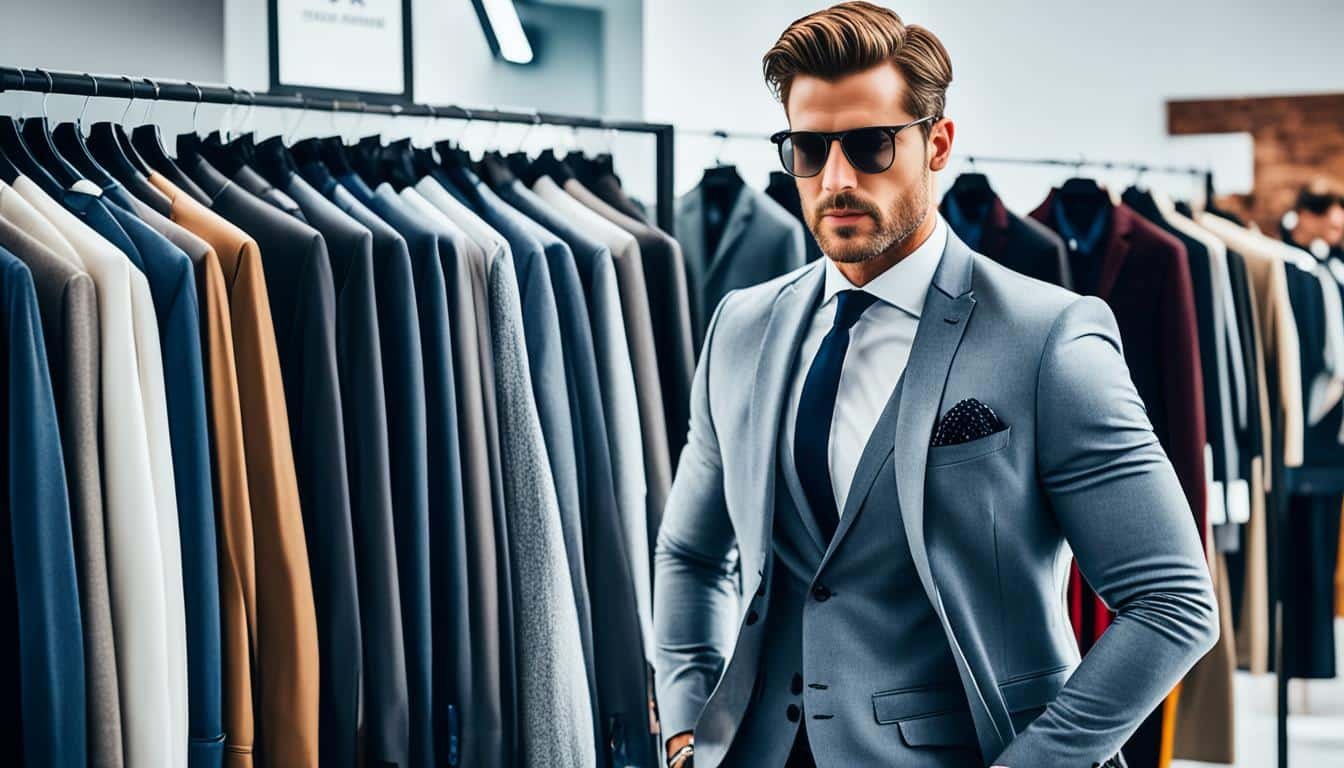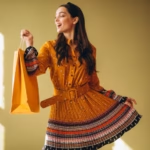Creating a cool, personalized wardrobe can feel overwhelming yet rewarding. This guide helps men get the basics to master shopping for men’s fashion. It touches on knowing your body shape, refining your style, and how to shop smart without breaking the bank.
Key Takeaways : Shopping For Men’s Fashion
- Understand your body type and posture to find the most flattering fit and silhouettes.
- Declutter and organize your existing wardrobe to create a foundation for building a cohesive style.
- Develop a personal aesthetic by identifying style inspirations and balancing classic pieces with trends.
- Shop strategically, focusing on versatile core items and selectively incorporating statement pieces.
- Leverage sales, discounts, and alternative shopping avenues to build a high-quality wardrobe on a budget.
Understanding Your Body Type and Posture
Knowing your body type and posture is key to finding the right clothes. First, learn about your body shape. You’ll also see any postural issues and how to deal with them.
Take Mirror Selfies and Assess Your Shape
Start with taking mirror selfies in tight clothes. Look at these images with a clear eye. Note what stands out, like wide hips or a big midsection. This helps you choose clothes that fit well.
Consider Your Posture and Stretching Routine
Good posture is as important as your shape. If you slouch or have a tilted pelvis, clothes won’t look right. Work on your posture with daily stretching. This makes your body function better.
Be Mindful of Your Diet and How Foods Make You Feel
What you eat affects how you move and feel. Notice which foods make you feel your best. Healthy eating boosts your energy and how you look and feel.
Measure Your Body for Accurate Sizing
Measure your body for the right clothes. Know your chest, waist, hips, and inseam sizes. This makes shopping easier and helps you look good in clothes that fit just right.
Focusing on your body awareness is the first step to a great style. This way, you can build a wardrobe that makes your body type and posture shine. This is the beginning of a style that’s uniquely you.
Organizing and Inventorying Your Wardrobe
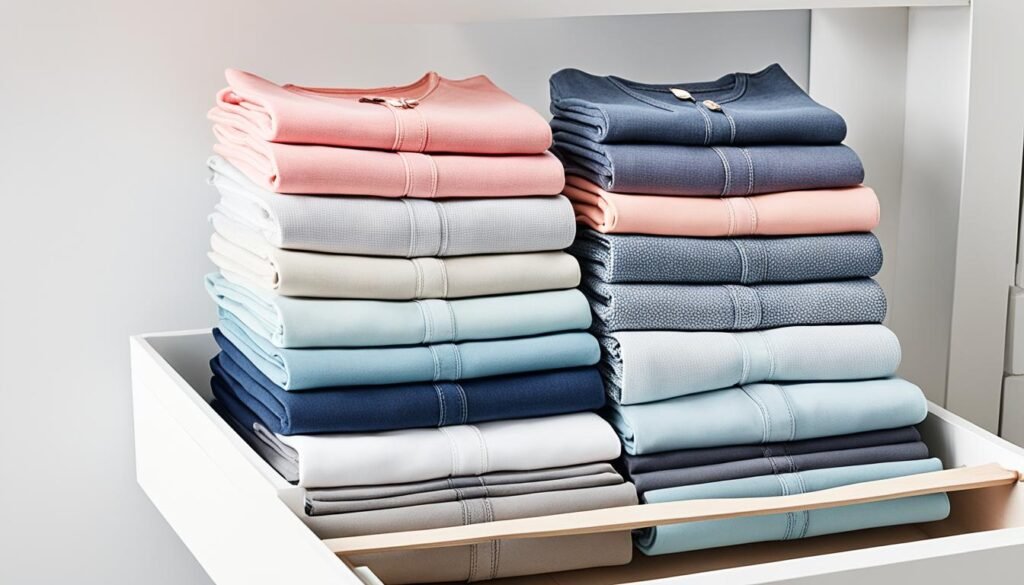
Before going on a shopping spree for more men’s fashion, you must organize your wardrobe. Start by decluttering, selling what’s valuable, and making a list of what you have.
Declutter and Donate Unwanted Clothes
Go through your closet and look at every item. Be honest about what you’ve worn in the past year. If you haven’t worn it, donate it. This clears space for new clothes and helps you focus on what you truly need.
Box Up Sentimental Items for Later
Many of us keep clothes with precious memories. Box these items and set them aside. You can go through them later, giving them the attention they deserve.
Resell Valuable Pieces Through Online Platforms
If you have high-quality fashion items you don’t wear, think about selling them online. Platforms like Grailed, Vestiaire Collective, or TheRealReal are great for this. You’ll declutter and maybe make some money back.
Catalog Your Existing Wardrobe Using Apps or Photos
After decluttering, use a closet organization app or take pictures of what’s left. This creates a visual wardrobe inventory. It lets you see what you have and what you might still need.
Organizing your closet well is the first step in having a great wardrobe. A well-organized wardrobe makes it easier to pick out stylish outfits. The key is to have a few high-quality, well-fitting clothes that you really love.
Developing Your Personal Style
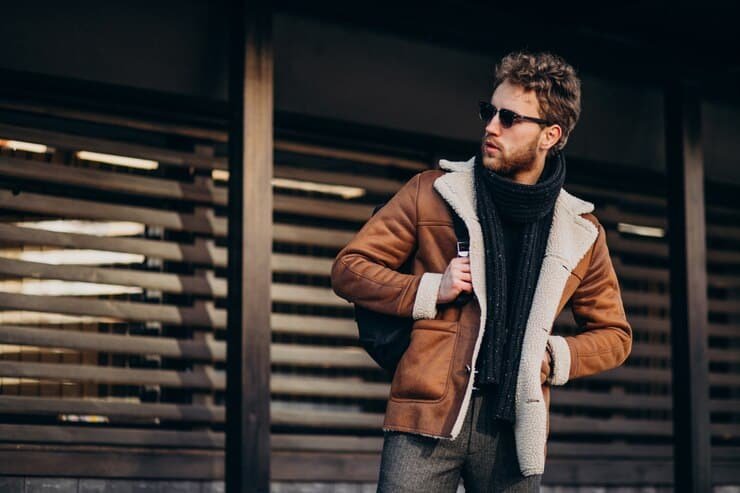
Creating a strong personal style is important. It showcases who you are. Find fashion icons you admire for their style. It’s okay if you can’t copy their exact look. Knowing the importance of proper fit is crucial too. It makes your style truly yours.
Identify Styles You Admire and Aspire To
Think about the style inspirations that speak to you. It might be someone’s cool vibe, someone’s elegant look, or a person’s daring choices. Look closely at what you like about their style. Then, work those details into your own wardrobe in a way that’s true to you.
Understand the Importance of Proper Fit
Remember, great personal style is also about fit and proportion. Learn what clothes best fit your body type and size. This understanding makes shopping smarter. It ensures your clothes look good and make you feel great.
Surround Yourself with Stylish Influences
Dive into visual inspiration for dressing well. Follow stylish people on social media. Read up on fashion in magazines and online. Also, make friends who value good classic styles and fashion trends. Being around these influences will push you to improve your style. It’ll help you try new things and refine your look.
Start with Classic Styles Before Incorporating Trends
It’s exciting to try the newest fashion trends. But, a timeless, classic style is the real foundation. Begin by getting quality, essential pieces for your wardrobe. These basics will help make your style both timeless and unique. Later, feel free to add trendy pieces to update your look.
Shopping For Men’s Fashion

Focus on getting clothes that easily mix and match. Start with neutral color palette items. These make it simple to put outfits together. Key pieces like t-shirts, jeans, button-downs, and trousers are a must. They help fill gaps in your wardrobe.
After getting these essentials, add accent pieces for flair. This includes belts, socks, and jewelry. They can make a basic outfit stand out. You can also try statement pieces like unique jackets or shirts. They let you have fun and try new looks.
Remember, it’s better to choose quality clothes over a lot of them. Good clothes last longer and look better. A wardrobe with high-quality, versatile items will be a great base for your style. This way, you can always look good without much effort.
Building a Cohesive Wardrobe
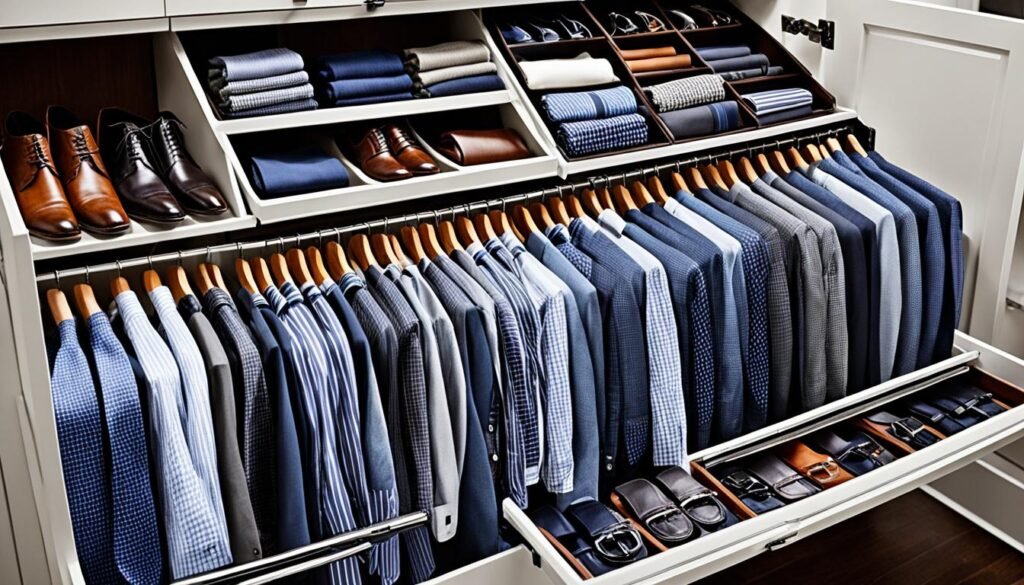
Now, it’s all about crafting a wardrobe that works well together. Start by mixing and matching your clothes. This way, you can create lots of outfit options that really show off your style.
Think about how each piece fits into your life and what you do every day. This will help you make smart choices when picking out new items.
Mix and Match Pieces for Multiple Outfit Options
Mixing and matching is like painting with your clothes. Try a white button-down with jeans one day. Then add a colorful scarf or a stylish belt.
Don’t stop there. Layering is your new best friend. Throw on a denim jacket or a knit sweater to make your look pop.
Consider Versatility and Lifestyle Needs
Your wardrobe should match your life. Pick clothes that go from work to play with ease. Versatile pieces are great because you can dress them up or down.
Incorporate Seasonal and Timeless Pieces
Have a good mix of clothes for every season. Choose light, breezy fabrics for summer and warm layers for winter. Make sure you grab some timeless pieces too.
A classic blazer, a white shirt, and dark jeans are must-haves. They never go out of style. With these tips, your wardrobe will always be on point and ready for any weather.
Mastering Fit and Proportion

A well-fitted, proportionate wardrobe is key to improving your style. We will focus on how clothes should fit and tailoring them for your shape.
Understand How Clothes Should Fit Your Body
Getting the best fit is all in the details. Clothes should fit just right: shoulders on edge, sleeves to the wrist bone, and pants to the top of your shoes. Knowing about fit helps you spot when something is too loose or too tight. This skill is crucial for a sharp look.
Learn About Tailoring and Alterations
Even high-quality clothes might need some tweaking. Tailoring and alterations can make them fit like a glove. Doing small things, like waist adjustments or sleeve shortenings, changes everything. Know a good tailor to keep your favorite pieces looking awesome.
Experiment with Silhouettes and Proportions
Different shapes and styles suit some body types more than others. Trying various options helps you find what makes you look great. For example, slim-fit trousers might make shorter legs seem longer. Or, loose tops can help balance wide shoulders. Exploring different tailorings and adjustments is about finding what fits you best.
Accessorizing and Finishing Touches
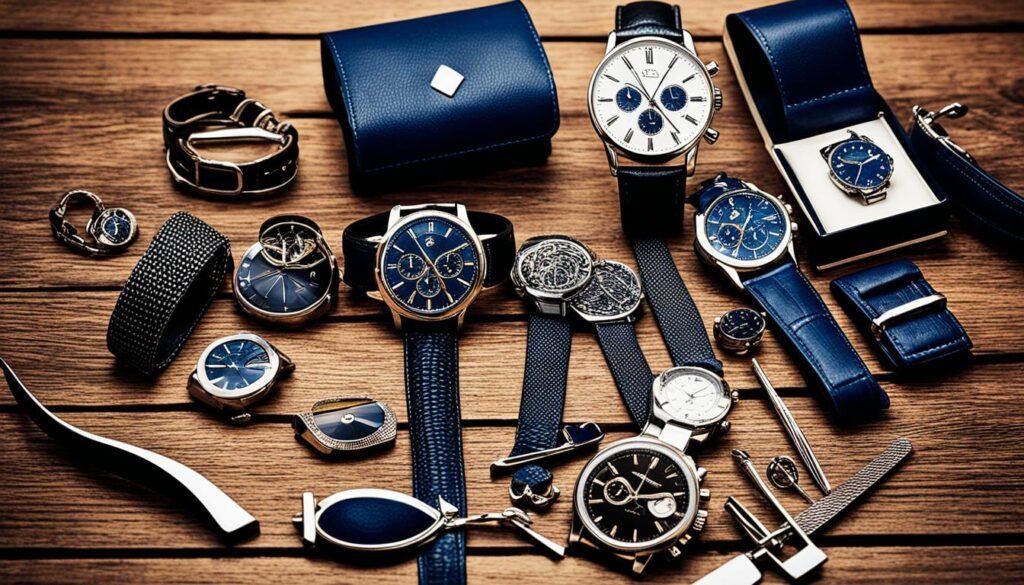
Accessories are the last touch that can make an outfit better. They show your personal style. Things like belts, hats, jewelry, and shoes allow you to show your unique look. They bring your whole outfit together.
Explore Different Types of Accessories
Start by trying out various accessories that go with your clothes. Choose leather or fabric belts to make your waist look great. Hats, like baseball caps or fedoras, make you look cool and stylish. Watches, cufflinks, and lapel pins add an elegant touch. Bags and shoes are also important for how your whole look comes together.
Understand How to Pair Accessories with Outfits
Knowing how to choose the right accessories makes your outfit complete. Think about the style and color of your clothes when picking accessories. A leather briefcase goes well with a suit, while a canvas tote is better for casual outfits. Remember, the right size and style of an accessory can make your whole style pop.
Develop a Signature Look with Personal Touches
The accessories that show your personality are the most powerful. Use special items like a vintage watch or a family ring to stand out. Personalized items, such as a monogrammed wallet or scarf, add a classy touch. With these special pieces, you can have a unique, well-put-together style.
Shopping Smart and Budgeting
Want a stylish wardrobe without emptying your wallet? This guide will show you how. It’s all about smart shopping and budgeting to get quality, versatile clothes without spending too much.
Invest in Quality Over Quantity
For guys, quality beats quantity in fashion. It’s better to buy high-quality clothes that last. Though they might cost more upfront, these pieces will save you money in the long term. They’re the key to smart men’s fashion budgeting.
Explore Different Shopping Avenues
Looking for great deals? Don’t just shop at regular stores. Check out online shops and resale platforms like Grailed or The RealReal too. You can find quality over quantity goods at low prices.
Utilize Sales and Discounts Strategically
Being smart means going for sales and discounts. Use seasonal offers wisely to save more money. With a little planning, you can get a great wardrobe for less. These shopping avenues and discounts are your friends in budget shopping.
Also Read : Exploring The Pitfalls Of Shopping Fast Fashion: A Critical Analysis
FAQs
Q: What are some essential items for men’s fashion shopping?
A: Essential items for men’s fashion shopping include tees, chinos, designer hoodies, dress pants, sneakers, and outerwear.
Q: Where can I find clothing for shorter men?
A: You can find clothing tailored for shorter men at brands like Asos, Porter, and Ssense which offer inseams suitable for shorter individuals.
Q: What are the best online clothing stores for men?
A: Some of the best online clothing stores for men include Asos, Zappos, and Ssense which offer top brands and free shipping options.
Q: How can I look good in casual attire?
A: To look good in casual attire, consider combining staple pieces like tees and sneakers with chinos or joggers for a stylish yet comfortable look.
Q: What are the benefits of shopping online for men’s fashion?
A: Shopping online for men’s fashion offers convenience, access to a wide range of brands and styles, free shipping options, and easy returns for customer satisfaction.
Q: Where can I find affordable men’s fashion options?
A: For affordable men’s fashion options, consider browsing through online stores like Asos, which offer a range of clothing at affordable prices.
Q: What are some go-to brands and styles for men’s fashion?
A: Some go-to brands and styles for men’s fashion include Nike for activewear, Acne Studios for high-quality men’s clothing, and old-school streetwear brands for a trendy look.
